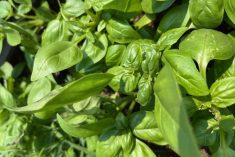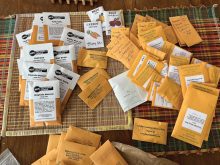In this article for Grainews I’ll introduce an autumn-flowering Prairie-hardy perennial that’s commonly known as sneezeweed. You may wish to start some from seed next spring.
Have you heard of betony (Stachys officinalis)? Got a boss or co-worker who gives you a headache? (Just kidding of course!) In case your headache is from some other source, it’s wise to investigate whether betony tea will work for you and bring relief. Consulting a reputable herbalist is a good start as headaches can result for a multitude of reasons.
Read Also

Gentle treatments for pain in the neck
Heading toward year-end, people unknowingly tense up against the cold and busyness, causing neck pain that can often be treated with appropriate support and gentle mobility, athletic therapist Kathlyn Hossack says.
Each year gardeners ask: “Is there any way to get rid of moles?” You may already have the essential ingredients of castor oil, liquid soap and hot pepper sauce in the house. I’ll include recipes, plus other tricks using cotton balls, sticks of chewing gum and a chocolate-flavoured laxative as additional tools to help drive moles out, so keep tuned.
To all my readers — you’re a swell bunch. I appreciate you. Thanks a lot for joining in!
Helenium (h. autumnale) also known as autumn sneezeweed
Sneezeweed is a late-summer/early-autumn-blooming perennial and an important food source for pollinators. Upright plants grow to 125 cm (50 inches) tall with each stem bearing up to 100 bright-yellow flowers arrayed on a single branch. Keep spent flowers picked and soil evenly moist during growing and flowering season so plants don’t dry out. Use sneezeweed to extend the life of a garden well past the first fall frosts. The plants look quite becoming in a natural cottage garden setting. In traditional borders, gardeners can choose to prune and stake sneezeweed to keep the plants well behaved. The common name — sneezeweed — is based on the ancient former use of its dried leaves and sometimes petals too in making snuff that was inhaled to cause sneezing. Tradition says such practice would supposedly rid the body of any unclean elements through the nostril breathing channels and sneezing that followed.
Clumps of sneezeweed make excellent additions to wildlife gardens where they can attract large numbers of beneficial insect and bird populations. One conservation society recommends planting sneezeweed to support honeybees. The same flowers are also known to attract butterflies, dragonflies and hover flies. A successful garden for wildlife is built on providing basics such as shelter, protection, food sources, water sources and nesting areas.
Native to North and Central America, Helenium, a.k.a. sneezeweed is an ideal perennial for a late-season garden as it will bring splashes of colour for weeks, lasting through into fall when other flowers are fading. Daisy-like bright-yellow flowers have showy petals that surround a brown cone covered with pollen to attract pollinators and provide a rest stop for butterflies. Allergy sufferers need not worry about planting sneezeweed, as the name only refers to its long-since-lost use. Planted in groups of three to five with other late bloomers will create a spectacular effect in your garden.
Seeds of H. autumnale a.k.a. Autumn Sneezeweed are available for purchase from West Coast Seeds, Delta, B.C. V4L 2P1, phone 1-888-804-8820, or shop online at westcoastseeds.com.
Betony (stachys officinalis) – a historical herb
After you read what betony may do, you might want to buy seeds or a started plant.
They’re available from Richters at Goodwood, Ont., L0C 1A0 — phone 1-800-668-4372 — or online at richters.com. Betony was used by the personal physician of Julius Caesar to treat no less than 47 different ailments. When it’s not gardening season, dried betony leaves have been brewed into a good caffeine-free substitute for black tea, closely resembling its taste. Soothe a sore throat, mouth and gums by gargling with the astringent quality in betony herb tea. In earlier times, betony tea was widely relied upon to treat insomnia, nervous headache and migraines. Betony liquid extract and tincture as a medicinal are available at some health and pure food stores.
The Celtic word for betony — that is to say: betonic — means good and refers to the centuries’ old practice of using betony to treat headaches. Early medical texts describe the ability of betony to relieve headaches as miraculous. Scientists have not yet been able to understand how betony can ease headaches. A Russian study found that betony contains compounds called glycosides that may explain supposed effectiveness at treating headaches and even insomnia.
When seeking relief from a sore and scratchy throat or a headache, there may be comfort waiting in a cup of hot steaming betony tea and you might even sleep better too. Drink no more than three cups of betony tea in a day as it may cause stomach irritation, so ease into it gently. There’s no guarantee that betony proves beneficial or provides healing as it did in Julius Caesar’s day. It’s always best to seek out a competent herbalist, health-care provider or family doctor to discuss any health issues of concern or when introducing something new.
Castor oil soil spray
Seeds of castor bean plants are known to be poisonous so it’s best to handle them with gloves of some kind. Leaves and roots exude a repellent that’s known to drive out moles, voles, shrews and mice. Castor oil which is not poisonous is made from a distillation process of compressed mash made from castor bean seeds.
Castor oil soil spray can be made as follows:
Combine one ounce of castor oil (1/8 cup) into four litres of warm water with several drops of liquid hot pepper sauce and a teaspoonful of liquid soap. Stir to help keep the oil dispersed. This recipe covers up to 300 square feet but you can double or triple it if required. Sprinkle this blend of ingredients from a spray can onto soil surface and/or on mounds where moles are suspected and down mole tunnel entrances. Right after rainfall or on moistened soil is the ideal time. This spray convinces moles to move out of their runs to elsewhere.
Castor oil cannon concentrate
Here is a concentrate to be diluted in water. This formula also works to eradicate moles and compels them to move on:
- One ounce liquid soap
- Two ounces castor oil
- Three ounces water.
Gently combine with an egg beater or a wooden spoon. If it gets foamy like beaten egg whites, let the mixture settle for a bit. Add two tablespoonfuls of castor oil cannon concentrate into an empty four-litre milk jug filled with water, or a one-gallon container.
Pour generous portions down each mole tunnel entranceway and over mole soil mounds. Repeat a second treatment in a day or two. Best results are obtained if applied after rainfall, or moisten the area to be treated first. You may need to add more concentrate to the water and strengthen the solution if moles are not eradicated after two applications spread a couple of days apart. This recipe also covers up to 300 square feet, but you can double or triple it if required. This action convinces moles to move out of their runs to elsewhere, “with castor oil runs.”
Norma (first name only) wrote: “I followed the directions you gave me. This stuff really worked. The moles moved on. That’s exactly what happened.”
Added supports are: Dip cotton balls in pure castor oil and push one a few inches into each mole entranceway. Wear gloves to reduce leaving any human scent. Chew a stick of sugar-sweet gum for a couple of minutes and then do the same thing. Stuff it down a mole hole. Roll sticks of Juicy Fruit gum into jelly roll style. Cut off slices from the edge and push down a slice into each mole channel. Rodents are unable to digest gum and become constipated. Cut a piece from a square of chocolate-flavoured laxative such as Ex-Lax and drop it or push with a stick into a mole tunnel. The consequences are severe diarrhea leading to dehydration. “Moles are gone is the word, so my ears have heard.” Here’s a word of caution in connection with any laxative, especially when it’s sweet and chewable. Ensure it’s always stored well away from children and pets to avoid adverse results that could be severe if eaten.
Folklore – fact or fiction?
Farmers, ranchers and weather watchers have confirmed much folklore through the years by watching specific signs and tuning into feelings and natural instinct. Some early prophetic legends have fallen by the wayside, while others seem to have withstood the test of time. How about this one? The following helped pioneers in deciding their home or farm site:
A cow with its tail to the west,
Makes weather the best.
A cow with its tail to the east,
Makes weather the least.
















